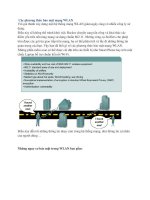bài giảng các phương thức tấn công mạng - cao hoàng nam
Bạn đang xem bản rút gọn của tài liệu. Xem và tải ngay bản đầy đủ của tài liệu tại đây (2.47 MB, 97 trang )
CỤC ỨNG DỤNG
CÔNG NGHỆ THÔNG TIN
TRUNG TÂM CHÍNH PHỦ ĐIỆN TỬ
Các phương thức tấn công
Cao Hoàng Nam
Các phương thức tấn công
•
Các phương pháp trinh sát, dò quét, thu thập thông tin
•
Các loại hình tấn công phổ biến
•
Đánh giá an toàn thông tin
•
Đánh giá lỗ hổng an toàn thông tin
•
Kiểm tra khả năng thâm nhập
•
Quản lý bản vá
Những vụ tấn công mạng "đình đám" thời gian qua
•
Tin tặc Trung Quốc tấn công website Philippines
•
Theo hãng tin ABS-CBN News, vào ngày 11/5, đã có tất cả 7 website của Philippines-trong đó có 2 website của
Chính phủ nước này-đã bị tin tặc đánh sập và thay đổi giao diện. Tin tặc đã thay đổi giao diện các website bằng dòng
chữ “HACKED BY CHINESE”
Những vụ tấn công mạng "đình đám" thời gian qua
•
Ngày 9/5, chỉ hai ngày sau khi Tổng thống Nga Vladimir Putin tuyên thệ nhậm chức, nhóm tin tặc nổi tiếng Anonymous tuyên bố
trên Twitter đã đánh sập cổng thông tin Chính phủ nước Nga (tại địa chỉ www.kremlin.ru), đồng thời khẳng định sẽ tiến hành
thêm nhiều đợt tấn công tương tự khác vào các website của Chính phủ nước này.
•
rước đó một ngày, vào ngày 8/5, nhóm tin tặc giấu mặt đã sử dụng phương pháp DDos (tấn công từ chối dịch vụ) để tấn công vào
website của Virgin Media - một trong những nhà cung cấp dịch vụ Internet lớn nhất tại Anh.
•
Hai hacker người Na Uy đã bị cơ quan đặc trách về tội ác tại Anh (SOCA) - vốn có vai trò tương đương FBI (Cục điều tra Liên
bang Mỹ) tóm gọn sau khi tấn công vào website của cơ quan này. Webiste của SOCA đã bị tê liệt trong vòng vài tiếng đồng hồ,
khiến nhiều công việc của cơ quan này bị gián đoạn và đặt các tài liệu mật của SOCA vào nguy cơ bị "rò rỉ" cao.
Những vụ tấn cộng mạng đình đám internet Việt trong năm qua
•
Diễn đàn chuyên về hack và bảo mật HVA đã trở thành nạn nhân của 2 vụ tấn công từ chối dịch vụ (DDOS) trong tháng 6/2011.
Rạng sáng ngày 5/6/2011, nhiều thành viên diễn đàn này thông báo tình trạng truy cập khó khăn hoặc hoàn toàn không truy cập
được. Cùng ngày, ban quản trị HVA có thông báo chính thức về sự cố trên, theo đó HVA đã có một lượng truy cập tăng đột biến
(lên đến 2.5Gbps), gây nghẽn toàn bộ đường truyền tới máy chủ.
•
Tháng 6/2011 cũng là thời điểm hàng loạt website có tên miền .gov.vn (website của cơ quan bộ ngành) bị hack. Theo thống kê từ
Bộ Thông tin Truyền thông, có 329 trang web tên miền .gov.vntrở thành nạn nhân của các vụ tấn công tính đến tháng 12/2011.
Bên cạnh đó, hàng loạt website có tên miền .org.vncũng trở thành đối tượng của các vụ tấn công tương tự.
•
Website Vietnamnet đã trải qua nhiều sự cố trong năm qua. Vào đầu năm (4/1/2011), một đợt tấn công từ chối dịch vụ nhắm vào
Vietnamnet khiến trang web bị tắc nghẽn nhiều giờ đồng hồ, gây khó khăn cho hàng triệu độc giả.
Những vụ tấn cộng mạng đình đám internet Việt trong năm qua
Các phương pháp trinh sát, dò quét, thu thập thông tin
•
Footprinting
•
Scanning Networks
•
Enumeration
•
Sniffing
•
Social Engineering
What is Footprinting
Why Footprinting
Why Footprinting
•
Know Security Posture: Performing footprinting on the target organization in a systematic and methodical
manner gives the complete profile of the organization’s security posture.
•
Reduce Attack Area: by using a combination of tools and techniques, attackers can take an unknown entity
(for example XYZ organization) and reduce it to a specific range of domain names, network blocks, and
individual IP addresses of systems directly connected to the Internet, as well as many other details pertaining
to its security posture
Why Footprinting
•
Build information database: a detailed footprint provides maximum information about the target
organization. Attackers can build their own information database about security weakness of the target
organization. This database can then be analyzed to find the easiest way to break into the organization’s
security perimeter.
•
Draw network map: combining footprinting techniques with tools such as Tracert allows the attacker to
create network diagrams of the target organization’s network presence. This network map represents their
understanding of the target’s Internet footprint. These network diagrams can guide the attack.
Objectives of Footprinting
Footprinting Methodology
Overview of Network Scanning
Types of Scanning
•
Port scanning: open ports and services
•
Network scanning: IP addresses
•
Vulnerability scanning: Presence of known weaknesses
Objectives of Network Scanning
Objectives of Network Scanning
•
Discovering live hosts, IP address, and open ports of live hosts running on network
•
Discovering open ports: open ports are the best means to break into a system or network, you can find easy ways to
break into the target organization’s network by discovering open ports on its network
Objectives of Network Scanning
•
Discovering operating systems and system architecture of the targeted system: this is also referred to as fingerprinting.
Here the attacker will try to launch the attack based on the operating system’s vulnerabilities.
•
Identifying the vulnerabilities and threats: vulnerabilities and threats are the security risks present in any system. You
can compromise the system or network by exploiting these vulnerabilities and threats
•
Detecting the associated network service of each port
Scanning Methodology
What is Enumeration
•
Enumeration is defined as the process of extracting user names, machine names, network resources, shares,
and services from a system.
•
In the enumeration phase, the attacker creates active connections to the system and performs directed
queries to gain more information about the target.
•
The attacker uses the gathered information to identify the vulnerabilities or weak points in system security
and then tries to exploit them.
What is Enumeration
Techniques for Enumeration
Technique for Enumeration
•
Extract user names using email Ids: every email ID contains two parts; one is user name and the other is
domain name. For example: , abc is user name and gmail.com is the domain name.
•
Extract information using the default passwords: many online resources provide lists of default passwords
assigned by the manufacturer for their products. Often users forgot to change the default passwords provided
by the manufacturer or developer of the product. If users don’t change their passwords for a long time, then
attackers can easily enumerate their data
Techniques for enumeration
•
Brute force Active Directory: Microsoft Active Directory is susceptible to a user name enumeration
weakness at the time of user-supplied input verification. This is the consequence of design error in the
application. If the “logon hours” feature is enabled, the attemps to the service authentication result in
varying error messages. Attackers take this advantage and exploit the weakness to enumerate valid user
names. If succeed, then the attackers can conduct a brute force attack to reveal respective passwords.
•
Extract user names using SNMP: attackers can easily guess the “strings” using this SNMP API through
which they can extract required user names.
Techniques for enumeration
•
Extract user groups from Windows: these extract user accounts from specified groups and store the results
and also verify if the session accounts are in the group or not.
•
Extract information using DNS Zone Transfer: DNS zone transfer reveals a lot of valuable information
about the particular zone you request. When a DNS zone transfer request is sent to the DNS server, the
server transfers its DNS records containing information such as DNS zone transfer. An attacker can get
valuable topological information about a target’s internal network using DNS zone transfer.









